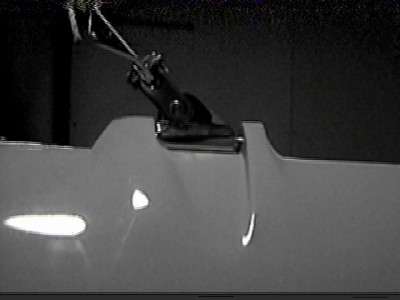Carbon chainplates sound good for marketing, but E-glass is just as good. Here is why. Imagine a 30 trimaran that weighs say 2000 lbs. The chain plate vertical load at overturning will be about 1000 lbs. Add in vector of shroud angle and crew and lets say a static plate load of 2000 lbs.
Hand layup and vacuum bagged carbon uni should have a tensile strength of some 80,000 to 120,000 psi depending. That means a chainplate of 1/35″ or 0.7mm. Now, tensile is not the only load, but for now assume it governs. Double it for grins and put one at each end of a rod or something. Even at 1/15″ (1.6mm) it looks way too weak to most of us. Most of us do not have an instinctive feel for how much carbon looks right. Most of us would only be comfortable if the thicknesses look to be at least what Skenes would require in stainless. That gives dozens of safety factors just to get it to look right.
E-glass uni will not be that much less tensile strength than the carbon uni. Expect maybe 60,000 to 70,000 psi tensile strength. So even with e-glass you will still have a safety factor of dozens. Carbon fiber does have better than twice the fatigue resistance, but the safety factors are so many, it doesn’t matter.
E-glass does provide better shock absorbing, theoretically. Its stretch to failure of around 6%, combined with the same from the resin, should help absorb shock. The only problem is that with a safety factor of 20 or so, the e-glass won’t give anyway. Its not loaded enough to give.
Carbon fiber is fun for this job, but not at all necessary. I know, its heresy.

So do the bulk in EGlass and cap it off with a layer of carbon for posterity and bragging rights.
not good mixing e-glass and carbon
Hi Kurt,
I am thinking about replacing the Stainless Steel Chainplates for the side stays of Equinox (37 ft fast cruising multihull, http://www.lifeatsea.nl) after 4 ocean crossings.
Should I tape the chainplate to the bulkhead where the current chainplate is bolted on ? Or is it better to glue the loads on to the inside of the hull?
Best regards,
Renzo
if what you had was working, do that. hard to know otherwise without seeing the boat.
Kurt, it’s refreshing to see another voice in favour of this technique. Your point about it looking strong enough is an interesting one. Folks who are used to regular plastics, or perhaps 25/75 F/R chopped strand, are invariably surprised by just how little material is required when using good unidirectional fibres in an appropriate orientation. Making it look right to them also makes it darned close to indestructible.
Nice post, I’ll be keeping an eye on your feeds from now on….
thanks Matt
You rock. My thanks for posting this. I will check to your site to read more and inform my people about your website.
thanks
Remember that sometimes the smartest persons make faults and typically really significant ones.
Indeed
Kurt,
The pic you show of the hounds… was that made with E-glass or c/fiber ?
The segment to the lefty in the picture appears to be the lower one (toward bott of mast) and it apears to be substantially bulked up, could you give the reasoning behind that? – or is that the camera angle?
Anyway, thanks for the nice info – will be really helpful for me
I believe it was carbon, but I needed something to show what I meant. I was troving around trying to find the actual plate one and didn’t find it until recently. I should probably add it,